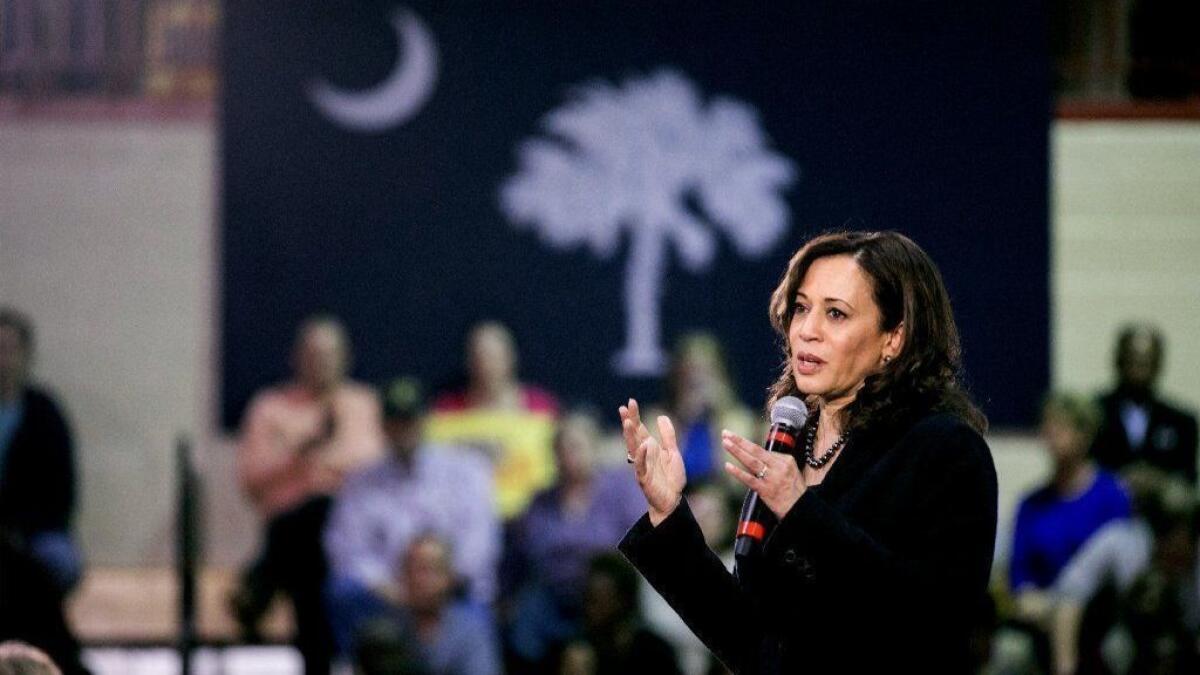Column: Buckle up for the crowded 2020 Democratic race. Here’s an early guide

- Share via
Reporting from Washington — The Democratic presidential campaign is likely to be the most crowded in decades, with 10 major candidates so far and more on the way. How’s a poor voter to tell them apart?
One easy shortcut is race, gender and geography — but that’s mostly just for pundits trying to handicap the race.
California’s Sen. Kamala Harris, for example, should do well among African American voters in South Carolina, an early primary state. Sen. Amy Klobuchar of Minnesota sees fertile ground in neighboring Iowa, the first caucus state.
Democrats looking beyond identity politics want a candidate they can fall in love with — especially one who can beat President Trump in the general election. How are they to choose?
One natural starting point is policy as the candidates stake out positions on major issues.
As in most years, the Democratic field ranges from moderate to progressive — from relative centrists Klobuchar and former Vice President Joe Biden (if he gets in) to Sens. Elizabeth Warren of Massachusetts and Bernie Sanders of Vermont on the left, with others in between.
But the details of policy may not be as helpful this time.
There’s not a vast gulf between the candidates on major issues such as taxes and healthcare. They all want to raise taxes on the wealthy. They all want to move toward universal health insurance.
Judging from this year’s cast, the Democrats are a purely liberal party now, a term once so loaded that candidates ran away from the L-word.
Even moderates now are well to the left of where Bill Clinton stood when he won the presidency in 1992. Clinton called for a crackdown on crime and stricter work requirements for welfare.
In that, the current candidates are following the voters. Last month, the Gallup Poll reported that a record high 51% of Democratic voters describe themselves as “liberal,” up from 30% in 2001.
“The Democratic Party has moved more decidedly to the left than any time in modern history,” historian Robert Dallek told me. “The issues they’re debating now — ‘Medicare for all,’ a $15 minimum wage — are the issues Bernie Sanders put on the table four years ago.”
Still, there’s one clear dividing line this year: the difference between radicals and reformers.
Every Democratic candidate agrees that the nation’s economic system hasn’t worked for the middle class and those struggling further down. But they offer different explanations.
On the left, Sanders and Warren charge that the system is “rigged,” and they want to overturn it. They blame billionaires, including the Wall Street tycoons who financed Hillary Clinton and other Democratic nominees.

Candidates such as Sens. Cory Booker of New Jersey and Kirsten Gillibrand of New York sound more like traditional reformers. To them, the system isn’t working and they want to fix it. The main problem, in their view, is Trump.
Even when the Democrats agree on goals, they disagree on how far to go and how fast. Health insurance may be the clearest litmus test.
Sanders has drafted a “Medicare for all” bill that would cover every American with government-administered health insurance and virtually eliminate private insurers.
Warren, Harris and Booker have endorsed the bill — but all have suggested they might soften its provisions, especially on private insurance.
Another common goal is free tuition at public universities, also a Sanders proposal from 2016. Warren, Harris and Gillibrand have endorsed the idea, but don’t agree on how to pay for it.
But Klobuchar, who calls herself “a pragmatic progressive,” says it’s too expensive. “If I was a magic genie and could give that to everyone … I would,” she said Tuesday.
There are differences on priorities too.
Harris and Booker have emphasized subsidies for low-income workers. Gillibrand has focused on universal, federally paid family leave for anyone who needs to care for a child or parent, financed by payroll taxes.
Sen. Sherrod Brown of Ohio, who is expected to join the fray, says he wants to restore “the dignity of work.” Beto O’Rourke, a former lawmaker from Texas, hasn’t settled on a theme or even whether he’s running.
And there are differences in tone. All the candidates promise to take Trump down, but their styles of combat vary.
“The American public wants a fighter,” says Harris, a former prosecutor. Warren answers Trump’s taunts of “Pocahontas” with gibes in return.
Booker has taken the opposite tack. He says he can overcome Trump with a campaign calling for unity and “love.” (Although, he admitted recently, “Love ain’t easy.”)
Democratic voters tell pollsters that they’re looking for two things.
One is electability — someone who will defeat Trump. Unfortunately, no one knows how to measure that enviable quality in advance.
The other is new faces. In a recent USA Today/Suffolk University poll, the option that attracted the most support was “someone entirely new.”
That suggests a path for a newcomer who can bridge the party’s two wings — a candidate like Booker, Brown, Harris or O’Rourke.
But we won’t know until they’re tested in debates, town halls, primaries and caucuses.
We complain about the wearying length of our campaigns, but it’s a good thing this one started so early. We’re going to need the time to sort all these characters out.
More to Read
Get the L.A. Times Politics newsletter
Deeply reported insights into legislation, politics and policy from Sacramento, Washington and beyond. In your inbox twice per week.
You may occasionally receive promotional content from the Los Angeles Times.











